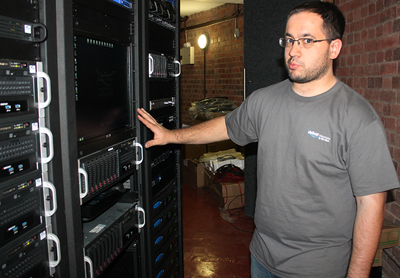 |
Mr Andrew Johnson, Sky-Skan engineer, explains how the dataprojector of the new digital planetarium functions.
10 October 2013 |
The University of the Free State (UFS) is the first in the world to boast a modern digital planetarium which was erected within an existing observatory.
It is also the first planetarium of its kind for Sub-Saharan Africa.
“What makes the project unique is the fact that we convert the existing observatory structure into a modern digital planetarium. It hasn’t been done anywhere else,” says Andrew Johnson, engineer at Sky-Skan, the company supplying the equipment and also installing it.
Andrew has worked on similar projects, with his company installing digital planetariums around the world.
What makes the planetarium so special is the fact that it offers visitors an inclusive experience.
“Previously visitors could only watch projected stars and constellations, but with the digital planetarium they can now experience a journey through space which feels very close to reality.”
Andrew points out that, apart from stargazing and travelling through space, the digital planetarium allows the audience to visit planets, explore the secrets of the oceans or even organs in the human body.
The planetarium will also be used for concerts, state-of-the-art presentations, theatre productions, as well as meetings, conferences and exhibitions.
The auditorium can seat approximately 90 adults or 120 children.
The digital dome that was recently fitted into the existing observatory structure, is a 12-metre seamless aluminium screen complemented by a powerful surround-sound system and multiple data projectors from Sky-Skan. This results in an immersive experience of the digital universe, as well as the recreation of the macro and micro cosmos an a variety of other environments.
The planetarium will be officially opened on Friday 1 November 2013 by Derek Hanekom, Minister of Science and Technology. Prof Matie Hoffman from the Department of Physics at the UFS is delighted at this visit from Minister Hanekom.
“This recognition and national interest demonstrates the importance and contribution of the first digital planetarium in Sub-Saharan Africa to science and astronomy. It is also evidence that a facility like this is important for the training of the next generation of scientists.”